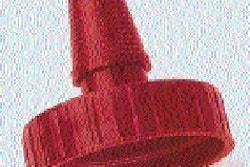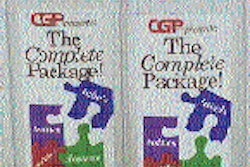Early in 1994, The Coleman Co., Wichita, KS, began a project to shift fiberboard packaging of its 1-gal containers of fuel to the new performance-oriented-packaging standards of the United Nations and the U.S. Department of Transportation. By early fall, the company's new corrugated boxes not only met the standards for worldwide shipping, but also were yielding savings of $63ꯠ in purchasing dollars. The new DOT HM 181 standards went into effect in 1993, but U.S. packagers were granted a one-year grace period until Oct. 1, '94 to achieve full compliance. For much of that year, Coleman used the previous approved containers as specified by the Interstate Commerce Commission. "Those container specifications made one tough box," says Frank Schmidt, a Coleman purchasing manager. "The ICC decreed what type of board could be used, the medium and the closure. There was no tolerance for creativity. "The new 4G fiberboard box regulations substitute performance standards for the former box material requirements. They're based strictly on how the box performs in approved tests. Essentially, if you can meet the performance standards with 'smoke and mirrors,' more power to you." The project began with Coleman's corrugated boxes that hold six 1-gal steel F-style cans of camping fuel. The product continues to be classified as a Red Label, Class II flammable petroleum naphtha liquid. It has its own UN number and product description as before. In fact, about the only copy change is new UN certification copy that replaces the former DOT 416 number that was the spec for the old box. Look to economize Coleman was convinced that performance standards would permit the use of a more modest container than the old ICC-spec. "We believed the old standard was an overbuild, so we expected we could find some savings in a new container," Schmidt says. The project was launched on the six 1-gal can box because it's one of the company's largest volume containers. About a million of those boxes are shipped every year. Coleman contacted its box supplier, the Kansas City plant of Union Camp Corp. (Wayne, NJ), about the program. Union Camp maintains its own testing lab that's located in Princeton, NJ. At first, Coleman tried to work with the lab by mail and over the phone, but it was too cumbersome and time-consuming. The company was making little progress until it learned about Yellow Logistics Services (Overland Park, KS). That company's laboratory in a Kansas City suburb was approved by DOT in early '94 as a certified lab for testing hazardous materials packages compliance with UN/DOT standards. YLS' lab was only about three miles from the Union Camp box plant, and only a two-hour drive from Coleman in Wichita. Plus, Schmidt says, their fees were reasonable. By mid-'94, Union Camp had prepared some prototype boxes at its plant. Coleman loaded up sample cans and took them to Kansas City for testing. Different tests For the basic tests, Coleman filled its F-style cans with water at weight equivalent to its fuel. That's because hazardous materials aren't allowed to be used during the actual tests. Cold drop tests were also required because Coleman seals its cans with a combination steel/plastic closure. For these tests, conducted at 0°F, Coleman filled the cans with a windshield washer solvent. "That worked out real well," Schmidt recalls. "It won't freeze and you don't have a problem with flammability. Plus the solvent is easier to dispose of than antifreeze. After the tests, everyone simply tops off his or her car reservoirs with the fluid." Since Schmidt was convinced the former box was overbuilt, he suggested that Union Camp make up some RSCs from 200#-test C-flute corrugated. Those boxes were tested, as were boxes made of 250#-test. That's how Coleman discovered the lighter box would meet all requirements of the performance standard. That change, says Schmidt, projects to an annual savings of $63ꯠ, coming directly from the lighter board weight. "Actually, we'll never see that money because it got washed out thanks to the price increases on corrugated board. However, in the face of rising paper prices, we've held our own." Changing box graphics When Coleman adopted the new box specification, it also decided to modernize its box graphics. Schmidt worked on the new graphics. "We went to the international pictogram symbols on the box so we could remove as much copy as possible. For every symbol you use, that's another word or phrase you don't have to print and also translate. We know that, down the road, we'll be shipping throughout the Americas, from Canada to South America. So we're beginning to prepare all our containers for what we call our trilingual packaging copy," Schmidt says. The Coleman fuel boxes haven't yet been changed; their trilingual design will go into production within a month or two. The box is currently printed flexo by Union Camp in black on kraft with red used to designate a flammable product. The timing of Coleman's change in graphics dovetailed with a helpful change north of the border. "In November, Canada finally fell in line with other countries on the red-diamond warning for flammable products," Schmidt reports. "For years, they had required that the red diamond be printed against a white background. That required us to add another color to our case printing." Coleman principally ships its fuel in the U.S. and Canada with some business in South America and the Caribbean. Although its previous ICC-approved box worked well, it was doubtful whether it would be approved for international shipments. Now, Schmidt says, Coleman can use the same box to ship across the street or to Chile. As expected, the company hasn't experienced any change in claims for damage. Most claims, the company says, derive from damage at transfer points, when a load falls or is hit by a forklift. So the shift to the new lighter container has essentially been "painless" to Coleman customers. Few customers have even noticed the change, Schmidt says. If they do, the company can point out that the new package requires less packaging material, and thus reduces the amount of material for customer disposal. "In the end, we invested about $4ꯠ to bring our box into compliance, and it's paid off with savings of $63ꯠ," says Schmidt with satisfaction.



























